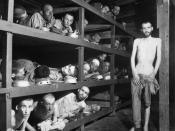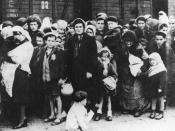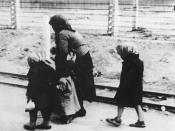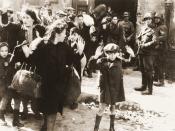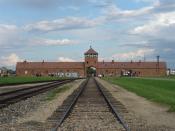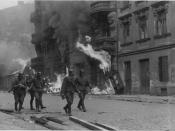Perhaps some of the most vivid images of the Holocaust are the death marches, when tens of thousands of Jews at one time were paraded to the extermination camps in Germany, Poland and Austria. Some of the more notable death marches included the mass march from the Warsaw Ghetto to the extermination camp at Auschwitz and the numerous marches that occurred following ghettoization related in Elie Wiesel's Night.
Though much of the modern world may find it difficult, if not impossible, to accept that notion that humankind can act with such disdain for human life, the objectification of the Jews as a component of the Nazi regime defined the acceptability of the death marches and the systematic extermination of innumerable populations of Jews.
One of the keys to the relative successes of Hitler's extermination plans was that few people escaped the horrors at the end of the death march, and so there were only a handful of people who were able to actually substantiate claims of mass extermination that took place at camps like Auschwitz, and even fewer who could fan the flames of resistance by retelling the horrific stories of what occurred to those who followed.
Some theorists argue that if the Jews had not been exposed to the kind of Nazi propaganda that was utilized as a control measure through out the early part of World War II that the mass exterminations would have been far less effective. At the same time, Nazi occupation of much of Europe during this period maintained an atmosphere capable of quelling resistance, even to the horrific death camp marches that occurred following increasing ghettoization of the Jewish population and subsequent implementation of the death march to exterminate large segments of the Jewish population.
Warsaw Perhaps one of the most interesting examples of the kinds of atrocities that occurred and the implementation of the death march can be assessed in the events that followed the ghettoization of the Jewish community in Warsaw. After the occupation of Poland, the Nazi regime determined the necessity centralizing the Jewish community, only to force many into the killing facilities at Auschwitz-Birkenau between 1942 and 1944. The views of some of the survivors of Auschwitz help to underscore the history of the ghettoization process and the quelling of opposition to Nazi control.
The process of ghettoization has been related in the stories of many of the survivors of the death marches, many of whom lived through ghettoization in Hungary and Poland under the directives of Adolph Eichmann (Smith 22). Under the plan for the Judenfrei-Europe (Jew-free), the directive was set for the use of the death marches to transport Jews from regions of Europe like Hungary to the more centralized extermination camps in Poland (Smith 22). Over 500,000 Hungarian Jews, for example, were exterminated in the midst of Hitler's plan, many of whom were transported to the Auschwitz-Birkenau death camps for extermination (Smith 22).
The German occupation of much of Europe caused considerable changes for the Jewish communities, especially in countries like Poland, Czechoslovakia and Hungary. Prior to the German military action, the Anglo-Polish mutual assistance agreement had assured that Poland would remain independent, but held no military value in the face of German occupation forces (Richardson uprising.htm). In August of 1939, the signing of the Mololov-Ribbentrop Pact determined the fate of Poland and it took just eight days for the Germans to advance on Warsaw (Richardson uprising.htm). Though the Polish Army worked in resistance to German occupation, the German "Blitzkrieg" or "lightening war" was unstoppable, and by late September, Warsaw fell with over 50,000 casualties in the city alone and some 25 percent of the buildings in ruins (Richardson uprising.htm). The demoralized and demolished Poland was conquered (Richardson uprising.htm).
The conditions of the surrender of Warsaw included a statement about the Jewish population, and a promise was made by the German Wehrmacht, General von Blaskowitz, that no harm would come to the Polish Jews (Richardson uprising.htm). But following the surrender, the German occupation marked a period of rumored activities, including the burning alive of rabbis and the mass slaughter of all the male inhabitants of the village of Pilica (Richardson uprising.htm). The general perception that spread within the Jewish community was that any agreement about the safety of the Jewish populations were grossly exaggerated and a sense of "shcrecklichkeit" or fearfulness quickly spread (Richardson uprising.htm).
In November of 1939, Hitler called for the abolishing of the existing military government in Poland and the creation of two differentiated political administrations, divided by regions (Richardson uprising.htm). The regions to the west and north were3 annexed by the German Reich and the regions of central Poland were defined as the "Generalgovernment," including four districts: Cracow, Radom, Warsaw and Lablin (Richardson uprising.htm). The Generalgovernment consisted of more than 36 thousand square miles and included a population of over 11 million, 1.4 million of whom were Jews (Richardson uprising.htm).
Reinhard Heydrick was the central figure in charge of the task of ethnic cleansing of the population and there were clearly three different populations being addressed by Heydrick: the political leadership, who were sent to concentration camps; the intelligentsia, who were imprisoned; and the Jews, who were placed in the ghettos, for what was called "re-education" (Richardson uprising.htm).
Unfortunately, some of the other distinct methods for controlling the Jewish population were hidden by other agendas, including the establishment of the Judenrat, or "Jewish councils" that were created in some ways to make acceptable the many necessary steps towards exterminating the Jews all together (Richardson uprising.htm). For example, one of the first orders of the Nazis to the Judenrat in Warsaw was the organization of a census, which was conducted in October of 1939.
The census gave the Nazis the information they needed to put into place a plan for the extermination of the Jews. The census found that there were at least 359,827 Jews in Warsaw and that many of them were land and business owners who still maintained a capacity for personal livelihood (Richardson uprising.htm). As a result, the Nazis determined the necessity for removing any immediate source of income and livelihood for all of the Jews in Warsaw as a part of the process of "cleansing" and determined a plan to exclude the Jews from the Polish economy (Richardson uprising.htm). In August of 1940, the Nazis announced that the city of Warsaw would be divided into three separate districts by ethnicity: German, Polish and Jewish (Richardson uprising.htm). The relocation of the Jews into the Warsaw ghetto occurred almost immediately, and between October and November of 1940, the mass resettlement of the Jewish community occurred in a systematic manner (Richardson uprising.htm).
By June of 1941, the Nazis had constructed a prison in the Jewish Ghetto for Jewish "criminals" and by May of 1942, the prison had some 1,300 detainees (500 of whom were children)(Richardson uprising.htm).
But the Jewish prison was just one of the many institutions introduced to further oppress the Jews. The lack of food and food distribution in the ghetto resulted in the systematic starvation of the ghetto population, and it was recognized that the German's were selective in any aid they provided, clearly avoiding any support to the Jewish community. Between September of 1939 and June of 1942, statistics suggest that as many as 100,000 deaths occurred as a result of starvation (Richardson uprising.htm). Life in the ghetto was perceived by many to be a death sentence. "Death from starvation is a gradual process in which only 50 percent of the population is affected.
Extermination Between 1940 and 1943, the German's systematically participated in the mass deportation of many of the Polish Jews, and the population of the Warsaw Ghetto decreased considerably. At the same time, the German's also cut rations and the availability of food and medical supplies to the region, creating what some have described as a process of "indirect extermination" that resulted in the death of tens of thousands of Jews over a period of less than two years (Richardson uprising.htm). In 1941 alone, 43,000 Jews died in the Warsaw Ghetto (Richardson uprising.htm). By 1942, the population of the Warsaw Ghetto was down from some 550,000 following the German occupation to just 70,000, many of whom were demoralized and hiding (Howe 29).
The mass deportation of the Jews occurred as a systematic process through out much of occupied Europe, and was integrated into a view of the transformation of many communities under ghettoization. As a result, the overall opposition was reduced and there was a general perception of the acceptance of the death marches as a component of the relocation process. Many people did not know that they faced extermination, but instead perceived the death marches as a relocation process that went hand in hand with the increasing development of the Jewish ghettos.
Some social theorists have argued that the narratives of the death marches, including the reflections outlined in Elie Wiesel's Night, often relate an initial sense of fear relative to the dissolution of the Jewish community, but not a fear that the end results of these marches would be the mass extermination of the population (Schwarz 221). It was not until individuals like Wiesel experienced the death marches and understood the kind of systematic violence that would be commonplace that fear actually nullified any sense of existing faith or hope. Of the initial transport process, Weisel wrote: The days were like nights, and the nights left the dregs of their darkness in our souls. The train was traveling slowly, often stopping for several hours and then setting off again.
It never ceased snowing. All through these days and nights we stayed crouching, one on top of the other, never speaking a word. We were no more than frozen bodies. Our eyes closed, we waited merely for the next stop, so that we could unload our dead (Weisel 94-95).
The marches themselves, which sometimes took place under the dark of night and over the course of days, were horrific experiences were acts of violence, torture and murder were committed with great regularity and without any kind of humanization or any sense of remorse.
Memorialization of the events that surrounded the death marches often embraced a sense of fragmentation, based on the fact that many of the people who were forced into these mass transport operations were never able to walk away. Benjamin Wilkomirski, in his work Fragments, attempts to direct a view of this kind of segmentation in the history of the European Jews, and struggles to find a greater correlation between personal history and the larger perspective. For Wilkomirski and others whom have created their narratives of the death marches, the process of developing a view of what occurred that is not negated by a sometimes anti-Semitic historiography of the era is at the heart of issues around expression of these events (Yudkin 485).
It has readily been recognized that the narratives of the Holocaust, including the narratives of the death marches and even the few stories that actually recount experiences in camps like Auschwitz and Dachau, are defined by a correlation between fictional elements and biographical information (Yudkin 485). Some theorists have asserted that this perspective is defined by the prevalence of varied accounts and the way in which the human mind attempts to dismiss the truly horrific in exchange for what can be accepted or at least socialized.
The link between the past and present, then, in regards to the death marches and the mass extermination of the Jews often underplays the level of horror that was most likely a common component of the Jewish experience during this era.
Conclusions In recent years, a number of different authors have developed their own perspectives and stories that relate the tales of their older generations and provide a second hand account of the events that occurred. In Ozick's The Shawl, for example, the author presents the story of a young woman, Rosa, and her experiences during the Holocaust, a story that relates to the history of the author, the families retelling of Holocaust experiences and the sense of greater concern for the overall view of the events that occurred rather than just a narrative of what can be perceived after years of separation from the terror (Lehmann 29). The simplicity of the story, which integrates past and present components, demonstrates the way in which the Holocaust experience dictated changes in many of the survivors' lives.
Unfortunately, the ability of the survivors of these events to create viable depictions of their experience has been relatively limited, and it is more common for family members to have defined an approach to recreating the events of the Holocaust and presenting sometimes typified perspectives on what occurred.
There is no way to deny the level of destruction caused by the Holocaust or reduce the impacts on the lives of survivors to simple sentence about the atrocities that occurred. But the violence and the degradation that was inherent in the ghettoization of the Jewish communities through out occupied Europe and the increasing sense that Jews were perceived as "vermin" rather than as a part of humankind is at the center of most narratives of the Holocaust created by survivors.
While it may be possible to ignore the kind of physical violence that occurred based on the need for emotional separation, there is no way to deny the historical content of the events surrounding the ushering of hundreds of thousands of Jews into the death camps and the mass extermination of most. The few survivors, though careful in their perspective, often demonstrate the complexities related to a retelling of the Holocaust story.
